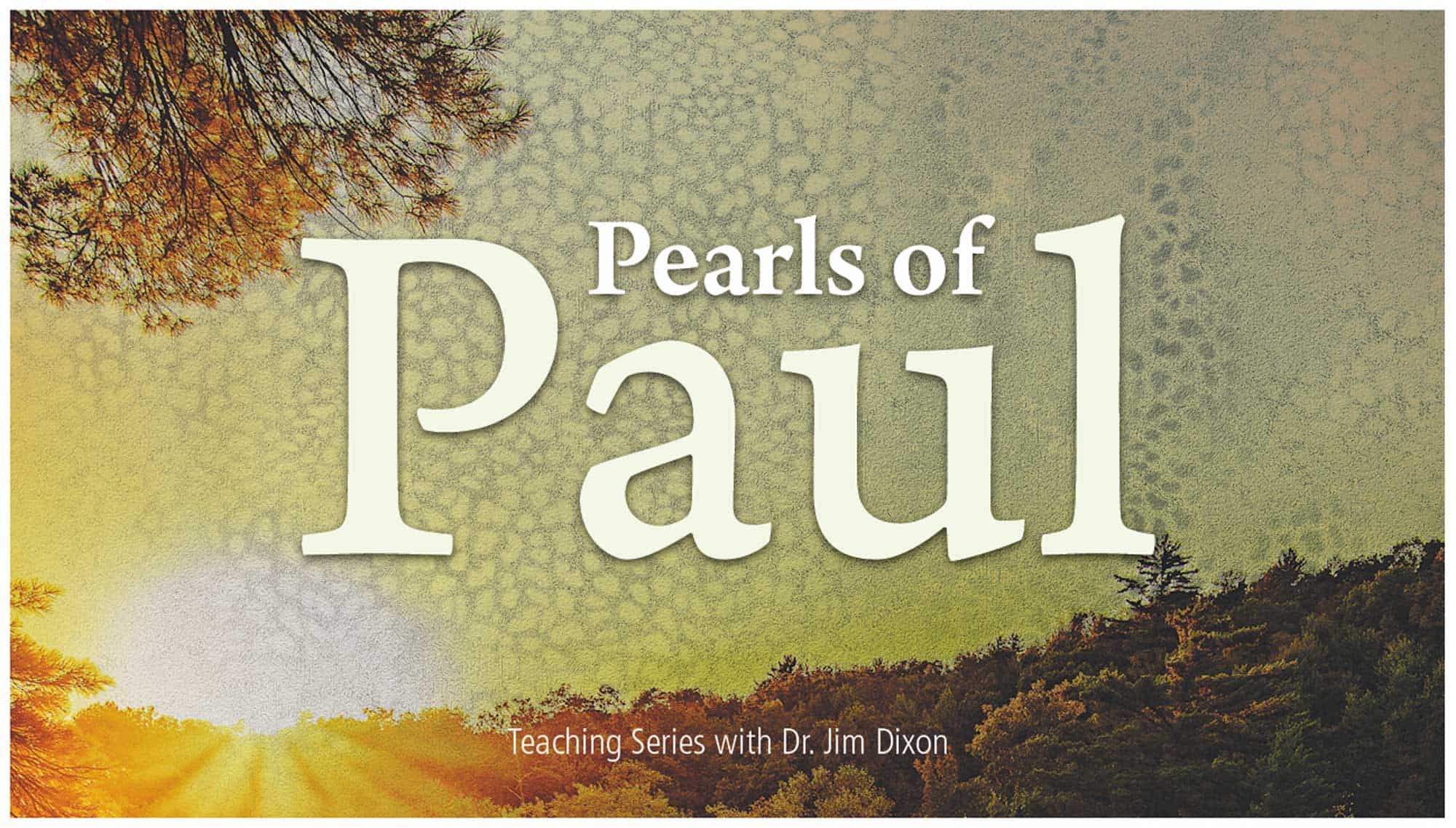PEARLS OF PAUL
THE FINAL JUDGEMENT AND THE CHURCH
COMMUNION SUNDAY
DR. JIM DIXON
1 CORINTHIANS 3:10-17
DECEMBER 5, 1999
The Cape Hatteras Lighthouse on Diamond Shoals, North Carolina, is one of the most beloved historic sites in America. The Candy-striped lighthouse was built in 1870, five years after the assassination of Abraham Lincoln. For thirty-three years, the Cape Hatteras Lighthouse rescued the perishing, and it kept ships from crashing into the rocks on that section of the North Carolina coast called The Graveyard of the Atlantic.
In the year 1903, engineers noticed something was wrong with the Cape Hatteras Lighthouse. Its foundation was eroding, and they realized that the lighthouse had been built on sinking sand. They wanted to move the lighthouse. The foundation could not be repaired, but they didn’t know how to move it. The lighthouse weighed 4,900 tons so, not knowing how to move the lighthouse, they just left it in its bad condition until the year 1930 when they could wait no longer. They built a railroad track from the lighthouse to another site one-half mile away where the foundation was to be firm, and they moved the Cape Hatteras Lighthouse over that track at a speed of one foot per hour. it took four months to move the Cape Hatteras Lighthouse one-half mile, but eventually they moved it to its new location thinking the foundation would be firm.
I talked to a person from North Carolina after the first service. The person told me that just this past year, they had to move the Cape Hatteras Lighthouse again because, once again, they found they had built it on sinking sand.
Jesus Christ said to His people in the Sermon on the Mount, “You are the light of the world. A city set on a hill cannot be hid, nor does one light a lamp and hide it under a bushel basket but sets it on a lampstand that it might give light to all who are in the house. So let your light shine amongst men that they might see your good deeds and glorify your Father who is in heaven.”
You see, the church of Jesus is called to be a lighthouse. This is true of the church universal, and it is true of the local church. We’re called to be a lighthouse to rescue the perishing. It’s true of Cherry Hills Community Church. We’re called to be a lighthouse.
Now, physically, our church has moved. It’s moved from Orchard Road to Colorado Boulevard, and it’s moved from Colorado Boulevard to Grace Boulevard. But spiritually we have not moved. We remain founded on a secure foundation of Jesus Christ. A lighthouse or any other building must have a firm foundation. We have that foundation in Jesus Christ. The Apostle Paul, in our passage of scripture for today, writes, “No foundation can anyone lay than that which has been laid which is Jesus Christ.” Everything else is sinking sand.
You can see our five-fold purposes on our Grace Notes. This church lives to exalt Christ, to bring people to Christ, to build people up in Christ, bond them in Christ, and send them out in Christ. It’s all about Christ. He’s our Cornerstone. He’s the foundation.
It is tragic but true that we live in a time where many churches across America and around the world have left their foundation and have now founded themselves on sinking sand. In the PCUSA, the Presbyterian Church USA, the denomination in which I was once ordained, there are approximately 10,000 churches. It is estimated that as many as 7,000 of those churches no longer preach Christ. They no longer focus on the cross of Christ. They no longer invite men and women to receive Christ as Lord and Savior. They no longer invite people to experience regeneration and rebirth. They’ve left their foundation.
This is not only true in the PCUSA. It is true in the United Methodist Church. It is true in the ELCA, the Evangelical Lutheran Church in America, which is not very evangelical. It is true in the Episcopal Church, and it is true in many expressions of the Catholic Church, and true in the American Baptist Church.
There are many good churches in all of these denominations, many wonderful churches, founded on Christ, preaching Christ, but the tragic truth is there are also many churches that have left the foundation of Christ and have deluded the gospel and they are built on sinking sand. So, we have this first message from Paul. The Church of Christ must be founded on Christ, built on that solid foundation.
In this passage from the Apostle Paul, the church of Christ is not really described as a lighthouse but as a building. We may think of that building as a lighthouse, and other passages of scripture do, but we may also think of that building as a temple as Paul does at the close of this passage. The church of Christ is not only called to be a lighthouse, but it’s called to be a temple because the Spirit of God dwells in the church of Christ.
From the year 500 BC to the year 600 AD, there lived a people in South America called the Nazca people. The Nazca people gave us those famous Nazca lines. They carved those lines, drew those lines into the Peruvian desert centuries ago. Now, the Nazca lines, many of which are 12 miles long, are not just lines. They are geoglyphs, drawings on the earth. Some of them are geometric drawings and some of them are drawings of animals. Some of the animals are as large as a football field, and they can only be deciphered from the air. You can only make out what they are from high above the earth. Now, the Nazca people disappeared 1300 years ago, but the geoglyphs, the Nazca lines, were not discovered until 1920 by an airplane high overhead, looking down and seeing these figures on the surface of the earth.
Since 1920, people have wondered why. Why did that ancient civilization draw these geoglyphs on the earth? For a long time, there was speculation. People talked about maybe they were into astrology or astronomy, and other people spoke of UFOs and all kinds of bizarre things. The last 17 years, archeologists have studied the Peruvian desert, the Nazca people, and the Nazca ruins. They now believe that it was all about religion. The Nazca people had drawn these straight lines in order to guide people to their sanctuaries, and to guide people to their temples, to their holy sites. The Nazca people had drawn these figures and these animals on the earth because many of those figures expressed or actually were images of their gods, or they were appeals to their gods. They thought that the gods would look down and see these huge drawings on the earth, and the gods would be moved, and they thought that the gods would perhaps provide for them or protect them because they did these things. It was all about religion.
Around the year 350 AD, earthquakes struck that section of the world, one after another, and El Niño brought mudslides. After the mudslides, there came a long period of drought, and their agriculture was destroyed. The Nazca people became angry with their gods. Historians and archeologists tell us that they began to reject their religion, and they began to torch their temples. They actually began to torch their temples, burn them down. Over a couple of hundred years, they completely rejected their faith, and they dissolved as a people because all of their identity was focused on their religion. Their whole community was focused on their religion. When they rejected that religion, they were soon absorbed by other peoples and nations, and they disappeared.
You might think, ‘Well, that’s not very surprising because they were primitive polytheists. They were polytheistic.’ And you might say, ‘Well, Christians would never do that. Christians would never reject their faith, never torch their temples.’ But, of course, Christians DO reject their faith, and history has shown us that. All you have to do is look at Harvard, Princeton and Yale and the Ivy League schools that were once founded by evangelical Christians and are today wholly secular. Somewhere along the line, Christians abandoned the faith. All you’ve got to do is look at DU, founded by evangelical Christians, founded by evangelical Methodists—today wholly secular. Somewhere along the line, Christians abandoned the faith. You can even look at Iliff Seminary, built on the DU campus, founded by evangelicals. Today it’s an illustration of syncretistic liberalism. Even seminaries can leave their foundations and abandon the faith. You can look at the YMCA, a wonderful organization, founded by evangelical Christians, but today, many local Y’s have nothing to do with Jesus Christ.
Of course, churches, too, sometimes leave their foundations, torch their temples. spiritually speaking. The Apostle Paul writes, ‘Do you not realize you are the temple of God, and the Spirit of God dwells within you. Whoever destroys God’s temple, God will destroy him for God’s temple is holy and that temple you are.’
The New York Times just recently had an article on Israel’s Y2K problem. According to the New York Times, Israel’s Y2K problem has nothing to do with computer technology. It has rather to do with the Temple Mount. According to the New York Times, Israel’s problem in the year 2000 and beyond concerns the Temple Mount.
You can travel to Israel today, you can stand on the Mount of Olives, you can look over at Mount Scopus, and you can see where Jeremiah once stood as he watched the Babylonians torch the city of Jerusalem. You can stand on the Mount of Olives, and you can look down at the Garden of Gethsemane where Jesus so often went to pray, to be alone, and where Judas once betrayed Christ. You can stand on the Mount of Olives and look across the Kidron Valley into the other side of the valley where you see the holy city. It’s like you step back in time. The holy city of Jerusalem still surrounded by walls, and within the city of Jerusalem you’ll see the Temple Mount, an elevated section, 35 acres in size.
The Temple Mount is respected by Christians, but it is holy to Jews and it is holy to Muslims. The Temple Mount is holy to Muslims because the Rock Moriah is on the Temple Mount. Muslims believe that Muhammed ascended into heaven from Rock Moriah on the Temple Mount in the city of Jerusalem. That’s why they built the Dome of the Rock on the Temple Mount 1,300 years ago. That structure is a sacred structure to the Islamic peoples. The Temple Mount is holy to the Muslims. Also, because they believe the Madi, the Muslim Messiah, will one day come and he will rule the world from the Rock Moriah. He will rule the world from the Temple Mount. And so, the Muslim people today say they will never give up the Temple Mount. They’ll never give it up. They’ll even go to war, even thermonuclear war if necessary. They’ll never give it up.
The Temple Mount is also holy to the Jew because the Bible tells us that the Rock Moriah was where Abraham offered up his son Isaac. Of course, from his son Isaac came all the Jewish people. The Temple Mount is holy to the Jewish people because on that mount the Temple of Solomon stood and Herod’s Temple stood. The Temple Mount is holy to the Jewish people because they believe the messiah, the “masiah,” will one day descend the Mount of Olives, cross the Kidron Valley, rise up the other side of the valley, pass through the golden gate, and make his way to the temple to sit on the throne of David and rule the world from there. They want to obliterate the Dome of the Rock, which they consider a desecration and an abomination, and they want to rebuild the temple for the Messiah when He comes. That’s Israel’s Y2K problem.
As Christians, we understand the importance of the Temple Mount. We understand that the Temple Mount has a place in prophecy. It has a place in eschatology. It has a place in the events that attend the end times. But we should also understand that that Temple Mount and whatever temple is built upon it pales in importance when compared with the true temple which is the church of Jesus Christ. You see, the church universal, that’s the true temple. And that’s why Paul writes, “Do you not know that you are the temple of God, and the Spirit of God dwells within you?” He’s not talking about individual Christians because the word “you” is in the plural. It’s a collective “you.” “Do you not realize that you collectively are the temple of God, and the Spirit of God dwells within you collectively—the church?”
And then he says, “Whoever destroys God’s temple, God will destroy him. For God’s temple is holy and that temple you are.” You see, the church is holy. It is a dwelling place of God in the Spirit, and here is a warning. Do not do anything to damage the church of Jesus Christ. Jesus said, “I will build My church and the powers of hell will not prevail against it.” You cannot torch the temple without bringing judgement upon yourself.
Liberalism torches the temple. I’m talking about theological liberalism. Theological liberalism torches the temple because it strips the church of Jesus Christ of doctrine and truth, and it perverts grace to license. Fundamentalism can also torch the temple because it strips the church of Jesus Christ of love and compassion and perverts grace to law.
I think what torches the temple of Christ more than anything else is simply apathy—the hundreds of thousands and millions of nominal Christians that do not serve the church of Christ on this earth. There’s a grave warning here to serve the church of Christ, founded on Christ. We’re all called to build on that foundation. All of us who belong to Christ, whether we’re pastors or Sunday school teachers or anything else, all of us who believe in Christ are called to be ministers, every one of us. If you believe in Christ, you are a minister called to serve His kingdom as long as you draw breath. How you serve the church of Christ when we come to judgement day… that’s what it’s going to be about. Christ is going to see whether you’ve served Him with gold, silver, and precious stones, or wood, hay, and straw.
“Some will be saved but only as through fire. Some will suffer loss of reward.” That’s what Paul is saying in 1 Corinthians, chapter 3. It’s about the church and how we serve it. Of course, when we speak of the church, we’re not just thinking of the local church. We’re thinking of the church universal. We’re thinking of missionaries. We’re thinking of what theologians call church and parachurch. We’re thinking of any ministry which, in the name of Christ, seeks to be salt or light on the earth. We’re thinking of Young Life and Campus Crusade and Youth for Christ, Fellowship of Christian Athletes, Athletes in Action. We’re thinking of World Vision, Food for the Hungry, all of those ministries which, in the name of Christ, seek to be salt and light on the earth.
Do you realize your call in Christ is to build these ministries? From the local church on, you’re call in Christ is to see that the church is strong. Jesus said, “I will build My church and the powers of hell will not prevail against it,” but He wants you to be a part. I’m not worried about the church. Friedrich Nietzsche in 1882 said, ‘God is dead,’ and he predicted the demise of religion in general and Christianity in particular. H. G. Wells and George Bernard Shaw they did the same. They were wrong, and they will pay an eternal price.
I’m not worried about the church. I’m worried about Christians and whether or not we’re serving the church. So, this is the call of Christ today. As we come to the Lord’s table, we remember that the early church in the Roman world, in the Latin world, one of the titles they gave communion was the title “The Sacramentum.” We understand that the word Sacramentum in the Latin means “sacred oath.” The Sacramentum was the sacred oath that a Roman soldier took when he joined the Roman Legions and when he pledged his life unto death in the service of the Emperor and the Empire.
The early church took this title and gave it to communion, the Sacramentum, because communion is not simply a time when we celebrate Christ dying for us. It’s not simply a time when we celebrate the cross, but it’s also a time when we consecrate ourselves anew and pledge to take up our cross and follow Him. And so, as we come to communion this morning, here’s an opportunity to pledge yourself anew, pledge your life anew to the service of Christ and the service of His church. Let’s have a word of prayer.


